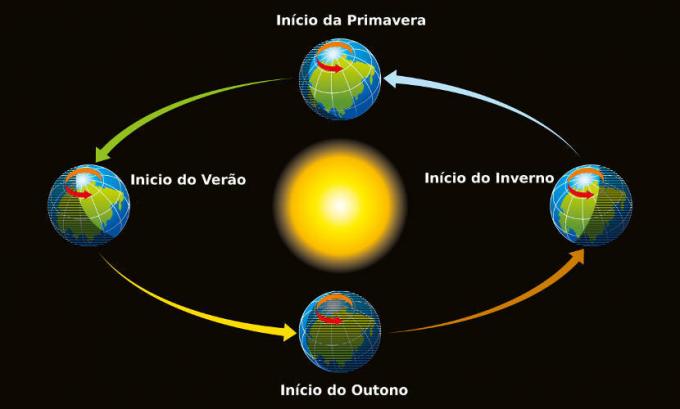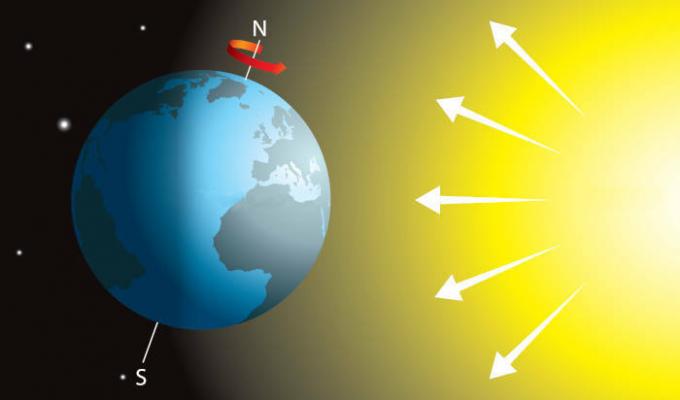land translation it's the movement that planet Earth performs around the Sun. The path taken by Earth it's called elliptical orbit, and the movement is performed in an elliptical (slightly oval) shape.
this movement lasts 365 days, 5 hours and 48 minutes. The time it takes the Earth to translate is called sidereal year. By convention, the calendar year was adopted, whose duration is 365 days. If we consider real time, every four years, the calendar year has 366 days and is known as leap year.

Consequences of translation
In addition to the succession of years already mentioned, the translation movement has as consequence at seasons. It is no coincidence that these have different characteristics and do not occur simultaneously in the hemispheres.
The explanation lies in the Earth's tilt axis perpendicular to its orbit. This axis is imaginary and crosses the planet from one geographic pole to another. The Earth then revolves around it. Due to this inclination,
the hemispheres are lit differently throughout the year.Thus, in a given period, one of the poles will be receiving a greater incidence of sunlight, while the other will have a longer period of darkness. This uneven solar lighting is what makes the seasons exist.

When one of the hemispheres is receiving more light it means that the sun is in its positioningmaximum, north or south, relative to the Earth's axis of inclination. When this insolation is greater in the Northern Hemisphere or in the Southern Hemisphere, what we call solstice. This astronomical phenomenon marks the beginning of summer It's from Winter and takes place twice a year: in June and December.
If the incidence solar for bigger, will occur the Summer Solstice, presenting days longer than nights; if the incidence for smaller, will occur the Winter Solstice, with shorter days and longer nights.
It is worth noting that in the regions near the equator there is not much differentiation between the seasons, which are, therefore, very similar throughout the year. A great example is Brazil, which, with the exception of the southern region, has only two well-defined seasons: one dry and one rainy.
This is because in these regions the Earth's inclination is not very expressive, therefore, the differentiation of the solar incidence is also not. Thus, the further away from the Equator the region is, the better defined the seasons.
However, there is also the time to average position of the Sun in relation to the Earth. This means that, at that moment, the Sun will be equally illuminating both hemispheres. Like the solstice, this astronomical phenomenon occurs twice a year, in March and September, and is known as equinox. The equinox marks the start of spring It's from autumn. As at that time the solar incidence is equal to the north and south, the days have the same duration as the nights.
Read too: How do the solstice and equinox occur?
Earth's translation speed

THE speed that the earth reaches during the translation movement is approximately 107,000 km per hour. However, it is worth noting that, despite the speed achieved, the movement is not perceived by us. This is only possible if we have a reference point that is outside the planet, a celestial body, for example, that is stationary or at a different speed.
That speed doesn't stay constant, changing as the planet approaches or moves away from the Sun. So, the closer the planet gets to that star, the greater the speed, and the further away it gets, the smaller it is.
THE approximation of the Earth in relation to the Sun is called the perihelion, being 147 million kilometers away. At perihelion, the translation speed is greater. O removal of the Earth in relation to the Sun is called the aphelion, being 152 million kilometers away. In aphelion, the translation speed is slower.
Also know:Why is the Earth round?
what causes the translation
The Earth is not static. However, for many years it was not clear that this planet and the others moved around the Sun. The first to say that the Sun was at the center of the Solar system and that the planets revolved around it was Galileo Galilei, an Italian physicist, mathematician and astronomer. His observation was essential to validate the theory of heliocentrism (theory that presents the Sun as the center of the Universe).
Subsequently, the Newton's Laws about inertia, which relate the movement of the planets to the force of interaction between them, and the Kepler's Laws, that approach the trajectory taken by the Earth around the Sun as an elliptical, allowed to verify that our planet is in constant motion.
land rotation

In addition to the translation movement, the Earth also performs the call rotation movement, on what it rotates around its own axis. Due to this movement, which lasts 23 hours, 56 minutes and 14 seconds, the periods of insolation on Earth alternate, resulting in days and nights. The average speed of the Earth's rotational movement is 1669 kilometers per hour and occurs in a counterclockwise direction, from west to east.
During rotation, some areas are receiving direct sunlight while others receive less or no sunlight. That's why while in Brazil we are at a certain time, in Japan its inhabitants are at another. Then came the need to create the call timezone. To learn more about the subject, read our text: Time zones.
Earth Movements
In addition to translation and rotation, the Earth performs other movements whose consequences are not so apparent to living beings. See some of them:
Precession |
Nutation |
Displacement of perihelion |
Also called precession of the equinoxes, this movement corresponds to the circular displacement that the Earth makes around its axis, in a clockwise direction. |
It corresponds to the oscillation caused in the Earth's rotation axis every 18.6 years, due to the gravitational force exerted by the Moon on it. |
It corresponds to the variation in the Earth's orbit around the Sun, repeating itself cyclically every 21,000 years. |


